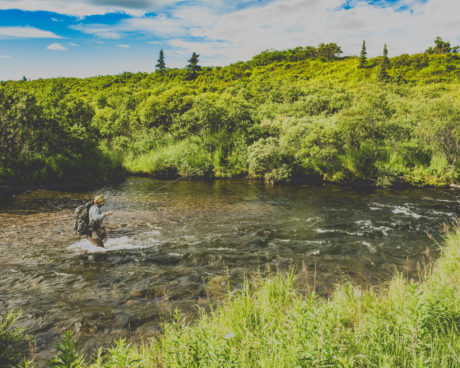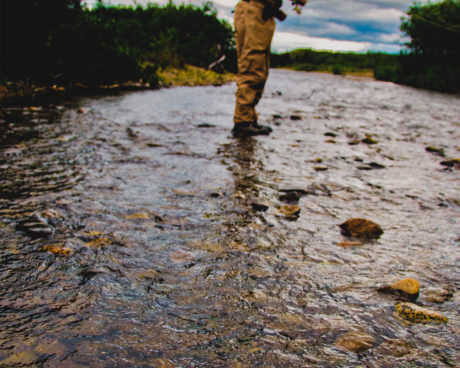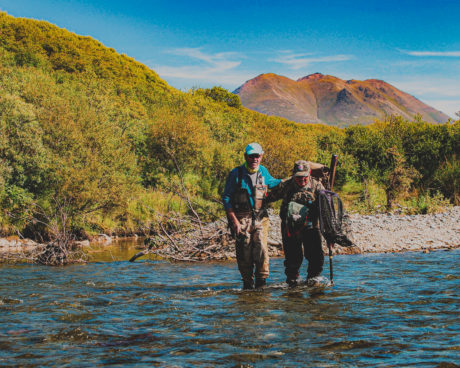
As fly fishing anglers, wherever you fish, you’re probably moving and at some point have to wade in the water you’re fishing. You move up, down, and across streams to find and access to the holes, sloughs, and seams that hold fish. With constant movement, it is inevitable you encounter a variety of currents, depth, and come across a variety of river bottom surfaces. Falling into a river or stream can lead to a very bad day, no matter how good the fishing is. Here are some tips and things to consider while wading in a stream or a river.

- Always wear a wading belt. When wearing waders, a wading belt is critical. Too many people ignore wearing their wading belts and that can lead to disaster. If you do fall into the water, the wading belt will impede the flow of water into your leg and foot compartments. If you do fall in, and the top of your waders fill up with water, a wading belt will keep your waders in place while you undo your straps and let the water out of the top. Changing your top is much easier than changing everything, top to bottom. This is one of those classics, “It’s better to have and not need,” rather than “need and not have.”
- Never move your weight from one foot to another until you have firmly placed your other foot on the ground. This is important especially in fast-moving water, regardless of how shallow it is. It doesn’t take much water to push your foot in a position where you lose balance. If you have to go slow, go slow. Shuffling across the bottom is another technique to prevent falls by minimizing the distance between the ground and your feet. However, shuffling in rivers where you have salmon, trout, or other species possibly spawning is frowned upon so please be mindful where you are and do it only when needed.
- Use a wading stick. Either a wading staff, hiking staff (they are more fragile), a long net, or even a sturdy branch will help you achieve three points for balance by placing the staff on the downstream side for additional support. It’s amazing how much easier it is when you have a wading staff while trying to cross a river or stream.
- Identify the best places to cross. Either the tail of a pool or at the head of a wide riffle. Of course, shallower water is better, but be mindful of the flow. Even shallow water can move fast.
- Always walk across at an upstream angle. If you have to turn back around it’s easier to follow the same line back.
- Always pivot or turn around in the upstream direction. Speaking of turning around, always pivot in the upstream direction, this way the force is going against the current helps to stabilize your position by leaning into the current.
- Stop and Rest if you have to. Wading is difficult. If you have to stop and rest, stop, and rest.
- Add traction to your rubber sole wading boots. Adding “bites” to your boot soles will increase your traction regardless of where you are wading. If you will be getting in and out of a boat or a plane, be aware boats and planes don’t like bites. In those situations, removable grips/soles are best.
- Pay attention to shallow water. Most falls while wading actually happen in shallow water, where the rocks are slick as snot. Be extra careful in slower shallow water.
- Use the buddy system – Just because your tall friend can cross doesn’t mean your short friend can. Unfortunately, height matters. No matter how tall you think you are, if you are short in stature you can’t always follow your tall buddy. Always let your friend or group know if you feel like you’ll be challenged crossing a river. Don’t let your pride or their lack of awareness get in the way of a safe fishing trip.

If you’ve never done any serious wading and are about to, these tips will help. Even if you are a seasoned veteran, it’s always good to be reminded of things to consider while wading. Safe wading and safe fishing!
I live in Highland Perthshire, Scotland on the banks of the River Tay.
Your weekly email and its contents are eagerly awaited, very informative and full of useful and up-to-date information.
Thank you,
This is not strictly speaking wading, but I just learned this tip.
If you are exiting a boat that is beached or anchored to wade, get out on the upstream side. The current will press you into the boat, giving you more stability until you have both feet on the bottom. Conversely, if you exit on the downstream side, the boat can swing into you before you have your feet firmly planted, and you can lose your footing. Ask me how I know.
Hello Laird, Thank you for reading our newsletter. We really appreciate it. If you have any specific topics you’re interested in, please let us know, and we will do our best to address it. Thanks, again.
Hi Jim,
Thanks very much for your comments and sharing your experience, it’s great to hear from you! We hope you continue to enjoy our content and please let us know if there are any fishing topics you’d like us to cover.
Keep having fun out there!
Our best,
The Deneki Team